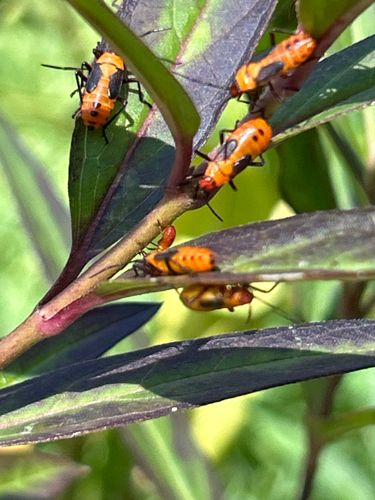Boxelder Bug
Scientific Name: Boisea trivittata
Order & Family: Hemiptera, Rhopalidae
Size: Adults typically measure about 11-14 mm (0.43-0.55 inches) in length. Nymphs, like those seen, are smaller and range in size depending on their developmental stage.

Natural Habitat
They are commonly found on or near boxelder trees, and other host trees. During colder months, they seek shelter in sunny, protected areas around homes, buildings, and in natural harborage.
Diet & Feeding
Boxelder bugs primarily feed on the sap and seeds of boxelder trees (Acer negundo), and occasionally on other maple trees (Acer spp.) and ash trees (Fraxinus spp.). Nymphs and adults use their piercing-sucking mouthparts to extract fluids from leaves, twigs, and seeds.
Behavior Patterns
Boxelder bugs are gregarious, often found in large aggregations, especially during cooler weather as they seek warmth. They are known to overwinter as adults in various sheltered locations, including cracks and crevices in houses, under tree bark, or in leaf litter. In spring, they emerge to feed and reproduce. Nymphs (like those pictured) develop through several instars before becoming adults. They are generally slow-moving.
Risks & Benefits
Boxelder bugs are generally considered nuisance pests. They do not bite humans, transmit diseases, or cause significant structural damage to homes. However, their aggregations can be unsightly, and they may stain light-colored surfaces with their excrement if crushed. They can also become problematic indoors during overwintering. They are not known to have significant benefits to the ecosystem, though they are a food source for some predators.
Identified on: 8/26/2025